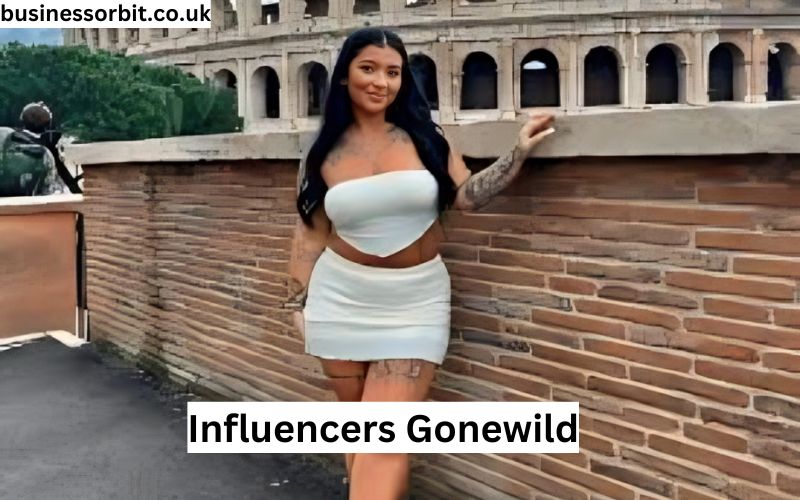In the past decade, social media has transformed from a casual platform for sharing photos and statuses to a global marketplace and arena for influencers. These digital personalities—individuals who have cultivated significant followings on platforms like Instagram, TikTok, and YouTube—have become central figures in advertising, pop culture, and even politics. With such an immense reach, influencers hold power over the opinions, trends, and behaviors of millions of people.
The word “influencer” today refers to a diverse group of individuals, from beauty gurus to gamers, fitness trainers, and lifestyle vloggers. But while many influencers maintain polished, professional images, some have opted to embrace more controversial, outlandish personas—choosing to take risks and push boundaries to gain even more attention. This behavior can often be labeled as “gone wild,” a term that encompasses everything from outrageous pranks to scandalous revelations, pushing the limits of what is considered acceptable online.
The Concept of “Gonewild”
The term “Gonewild” itself has origins in internet subcultures, often associated with content that is risqué or extreme. While the term can be linked to a specific genre of adult content, it has transcended this meaning to also encompass influencers who engage in shocking, often controversial behavior that pushes the envelope in their quest for viral fame.
On a broad level, “gonewild” behavior from influencers is about self-exploitation for the sake of social media fame and financial gain.
This could mean any number of things, from inappropriate content to behavior meant to stir the pot with followers or the media. Influencers who embrace this tactic tend to operate under the belief that, in the competitive world of digital content, being bold, edgy, or even taboo is often the fastest way to go viral and build a larger following.
But what makes this behavior so compelling, both for the influencers and their audiences? To understand this, we need to look at the psychology behind the culture of attention and social media algorithms.
The Psychology of Going Wild: Why Some Influencers Push Boundaries
The psychology behind influencers who push boundaries can be traced to several key factors:
- The Desire for Attention and Validation
Humans are social creatures, and in the digital age, the pursuit of attention has taken on a new form. For influencers, validation can come in the form of likes, comments, and shares. This constant influx of social feedback is highly addictive. The more attention an influencer receives, the more they feel validated, which leads them to post even more extreme content to maintain their “high.” - The Impact of Social Media Algorithms
Social media platforms, especially TikTok and Instagram, reward content that gets attention, regardless of its quality or message. The more engagement a post gets, the more likely it is to appear on more people’s feeds. This algorithmic reinforcement makes it increasingly difficult for influencers to stand out without doing something extreme or unexpected. As such, shock value becomes a strategy—one that’s sometimes pushed to its limits. - Shock Value as a Marketing Tool
In an age where oversaturation of content is the norm, influencers have learned that it’s often the most shocking or outrageous content that will capture attention. Doing something “wild” guarantees that the influencer will get noticed, whether through a viral video or a media controversy. Even negative attention can be spun into an opportunity for growth or a marketing angle.
Famous Examples of Influencers Gone Wild
There are a number of influencers whose behavior has captured the public’s eye due to their wild actions. Some have profited from these stunts, while others have faced serious backlash.
- Jake Paul
Jake Paul, a former Disney star turned YouTuber, is one of the most prominent examples of an influencer who has gained fame through controversy. His pranks, stunts, and constant disregard for rules have earned him millions of followers. However, they have also resulted in numerous scandals, from a neighborhood riot in Los Angeles to questionable content that led to the demonetization of his videos. - Lana Rhoades
Former adult film star Lana Rhoades has transitioned into a social media influencer, attracting millions of followers across platforms. While much of her content revolves around body positivity and entrepreneurship, Rhoades has also leaned into her provocative past to create viral moments that keep her relevant and engaged with her audience. - Tana Mongeau
Tana Mongeau’s entire career has been built on being “wild.” Known for her controversial YouTube videos and chaotic public persona, she often courts drama, controversy, and scandal, whether through elaborate “fake” stunts or feuds with fellow influencers. Her antics—such as the infamous “TanaCon” event, which was widely seen as a failure—have kept her in the spotlight.
Ethical Dilemmas and Consequences
While shocking behavior might garner attention, there are serious ethical dilemmas at play. Influencers who go wild can face significant consequences, both for themselves and their followers. Some of these include:
- Mental Health and Wellbeing
Constantly seeking validation can take a toll on an influencer’s mental health. The pressure to outdo one’s last stunt or post something more extreme can lead to burnout, anxiety, and even depression. In some extreme cases, influencers may feel like they have to push past their own boundaries, leading to potentially harmful consequences for both themselves and their followers. - Damage to Personal Branding
Influencers who push boundaries often find that they alienate certain groups of followers, brands, or even sponsors. Once an influencer builds a reputation for scandalous or controversial behavior, it becomes difficult to shift back to more mainstream, acceptable content. This can limit potential brand partnerships and hinder long-term career growth. - The Influence on Younger Audiences
Given that many social media platforms are heavily frequented by teenagers and young adults, influencers have a large responsibility in shaping the behavior of their audiences. Wild stunts or messages might be normalized for impressionable young minds, encouraging risky or unethical behavior. - Legal and Social Consequences
In extreme cases, going wild on social media can lead to legal action. Whether it’s engaging in public indecency, defamation, or violating the terms of service of a platform, influencers can face lawsuits, fines, or even jail time. The more extreme the content, the higher the likelihood that influencers may run afoul of the law.
The Role of Audience and Followers
The dynamic between influencers and their followers is a symbiotic one. Audiences are complicit in fueling the “wild” content by engaging with it—whether by liking, sharing, or commenting.
This creates a feedback loop: as influencers see that their extreme behavior generates more attention, they double down, continuing to push the boundaries of what’s acceptable.
Influencers’ followers play a huge role in shaping the type of content that goes viral. If the audience rewards controversial behavior with likes and shares, it encourages influencers to keep going further to maintain the cycle of engagement.
Some followers even participate in creating drama or controversy by leaving incendiary comments or spreading rumors, creating a culture of constant controversy that feeds both the influencer and the audience.
Influencer Platforms and Regulations
Social media platforms have increasingly come under scrutiny for their handling of extreme or harmful content. In response, many platforms have tightened their community guidelines to regulate offensive, hateful, or explicit material.
However, many of these rules are inconsistently enforced, and platforms like TikTok, Instagram, and YouTube continue to struggle with balancing the needs for user engagement with the need for appropriate content.
As the pressure on platforms grows, it is likely that we will see more regulations aimed at controlling influencer behavior. This could include stricter guidelines on the types of content that influencers can post or the development of new mechanisms for flagging and removing inappropriate posts.
Alternatives to Going Wild: Ethical Influencers and Positive Impact
Not all influencers choose the “wild” path. Many social media stars are carving out space for themselves by focusing on authenticity, education, and positive social impact.
Influencers who prioritize honesty and real conversations about mental health, diversity, and sustainability are showing that it’s possible to gain large followings while staying true to one’s values.
Influencers such as Emma Chamberlain, who is known for her relatable and self-deprecating humor, or Liza Koshy, who balances comedy with meaningful content, represent a growing trend of influencers who prioritize creating a genuine connection with their audiences over engaging in shock tactics.
These influencers are able to build sustainable careers without the need for extreme or controversial behavior.
The Future of Influencer Culture
Looking ahead, influencer culture will likely continue to evolve. As audiences demand more authenticity and transparency, the model of “going wild” might lose its appeal in favor of more responsible and sustainable content creation.
Brands will increasingly recognize the value of influencers who can maintain long-term positive relationships with their audiences, which could lead to a shift away from shock tactics and toward more thoughtful, ethical content.
See Also: Understanding the Javasea.me Leaks and the AIO-TLP287
Conclusion: The Evolving Role of Influencers
In the ever-changing world of social media, influencers who go wild may continue to attract attention. However, as digital literacy and the desire for authenticity grow among audiences, the future of influencer culture might take a turn towards responsibility and meaningful impact. Whether or not extreme content continues to dominate the scene, the ultimate power lies with the audience, and they may begin to favor substance over sensationalism.
In the end, while the lure of fame and fortune through wild behavior may still draw influencers in, the long-term success of social media influencers may rest on their ability to evolve beyond controversy and become sources of positive change and inspiration.




